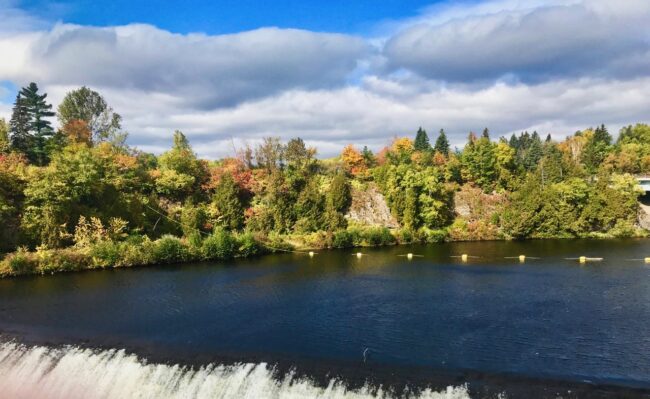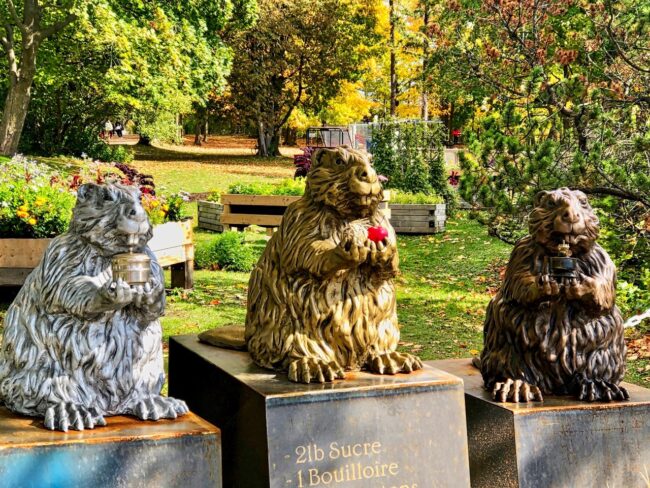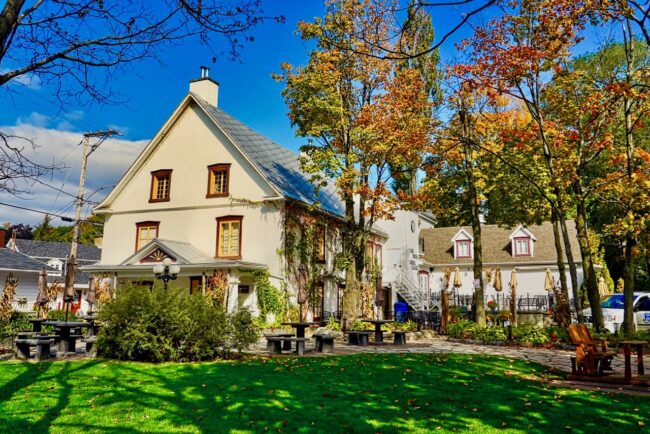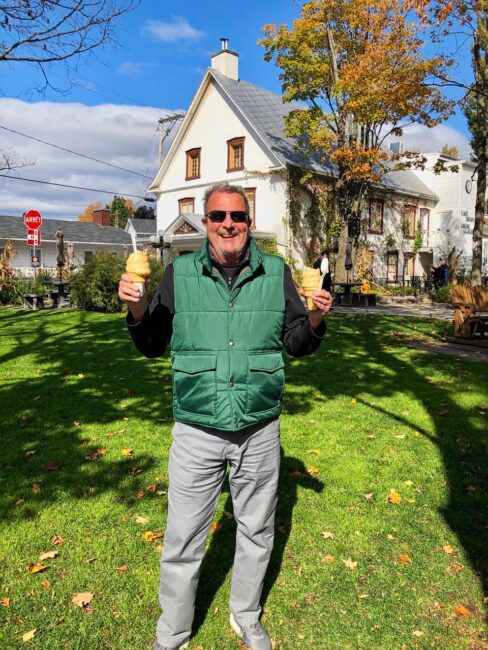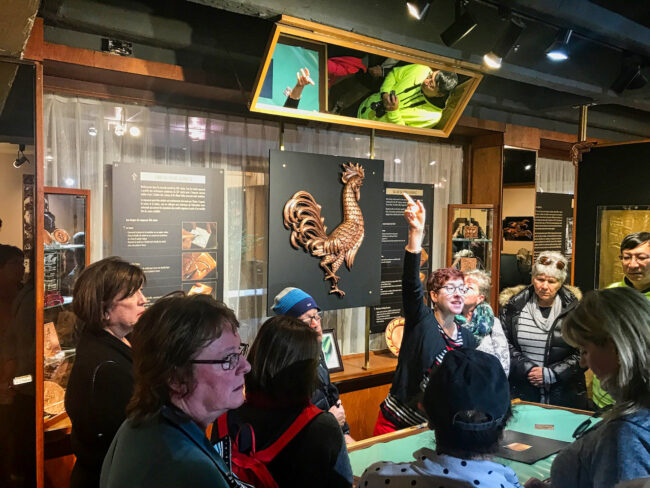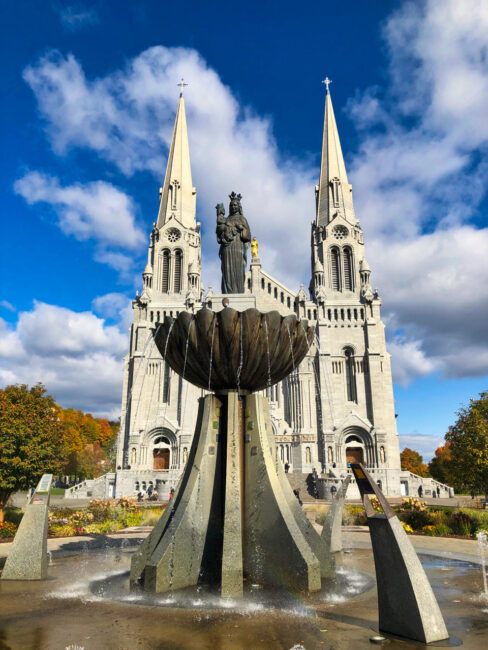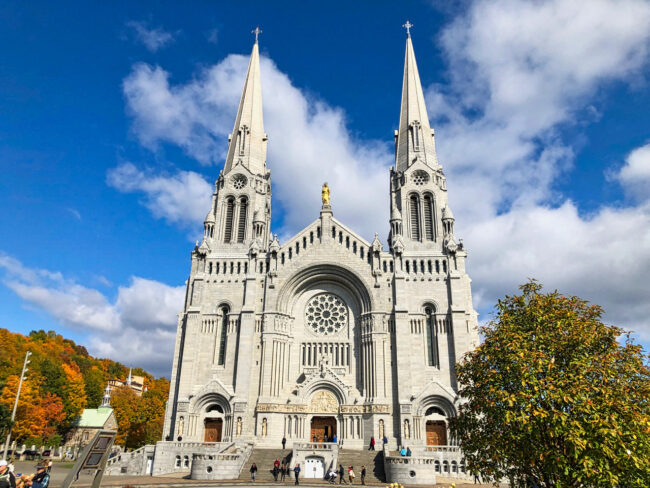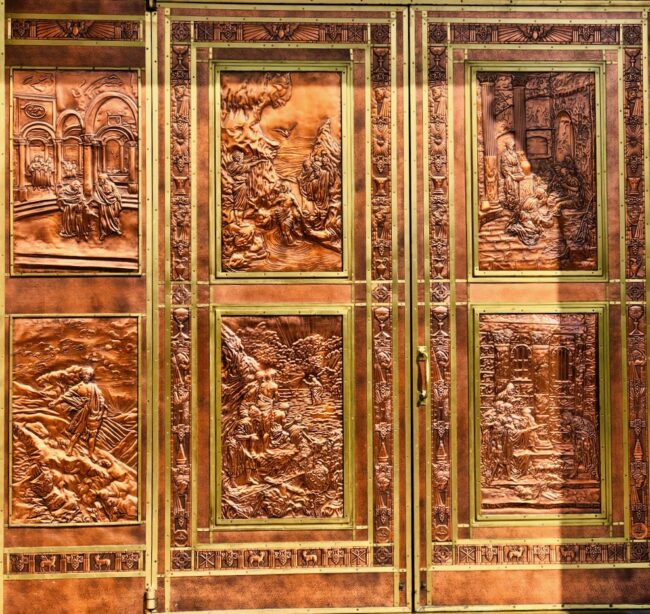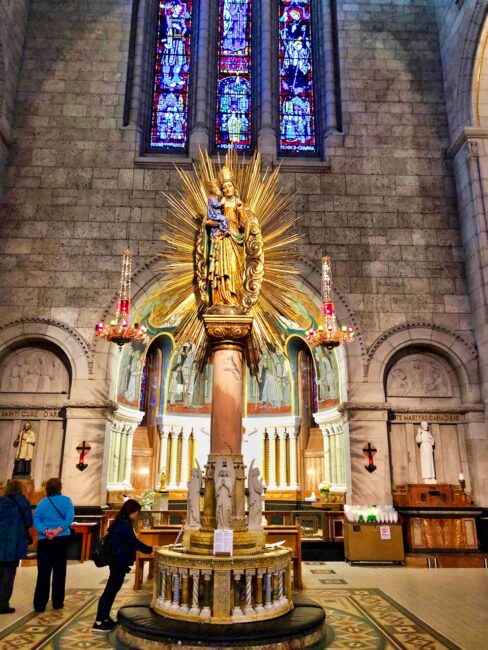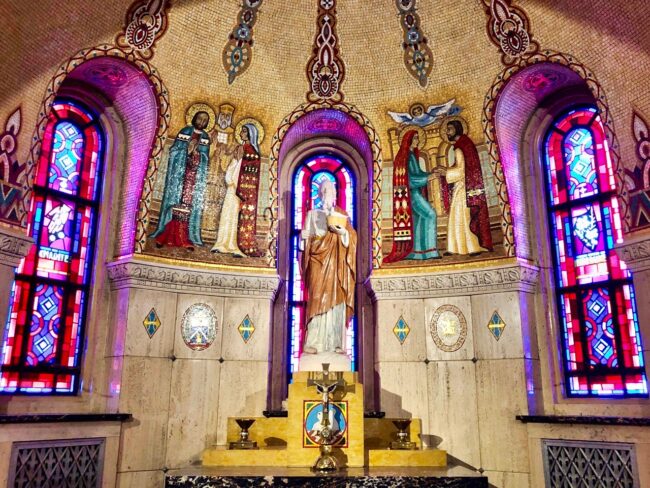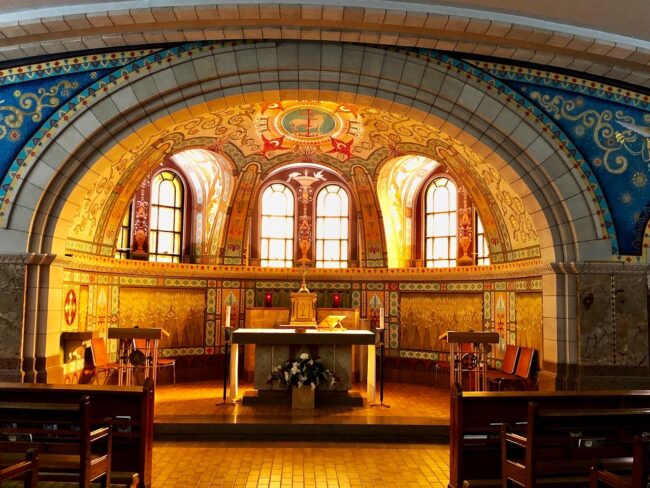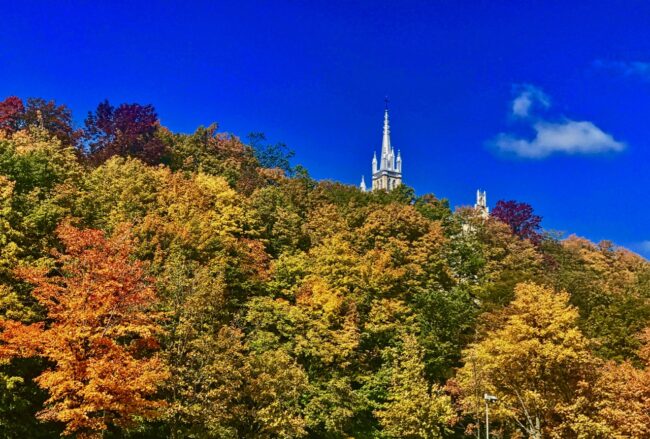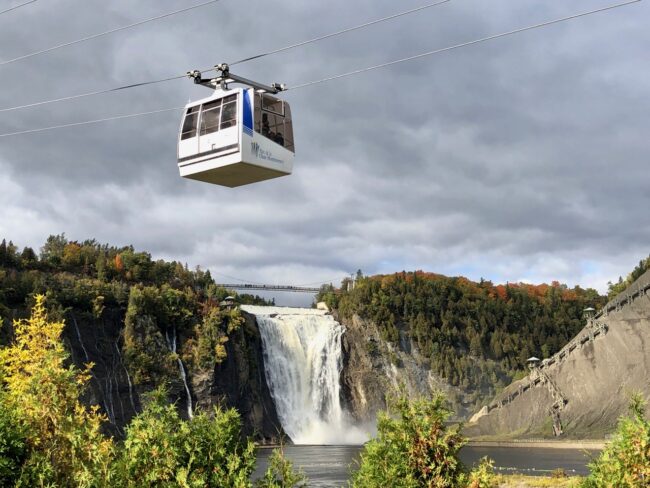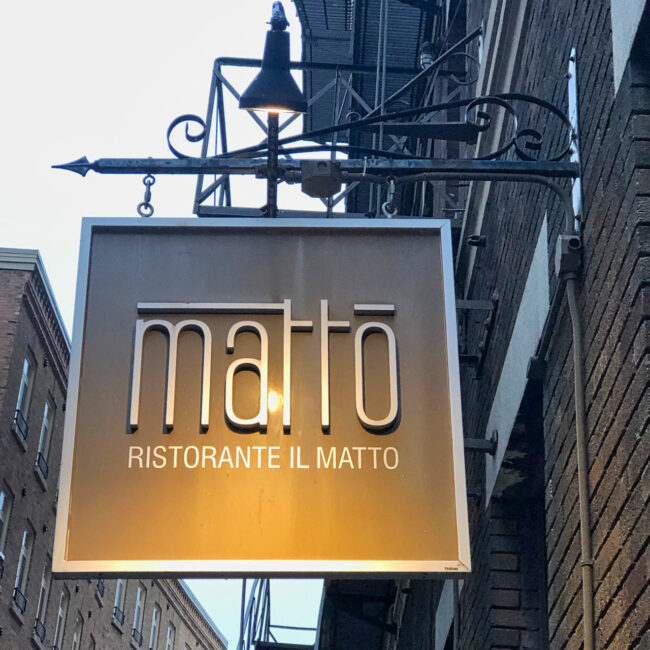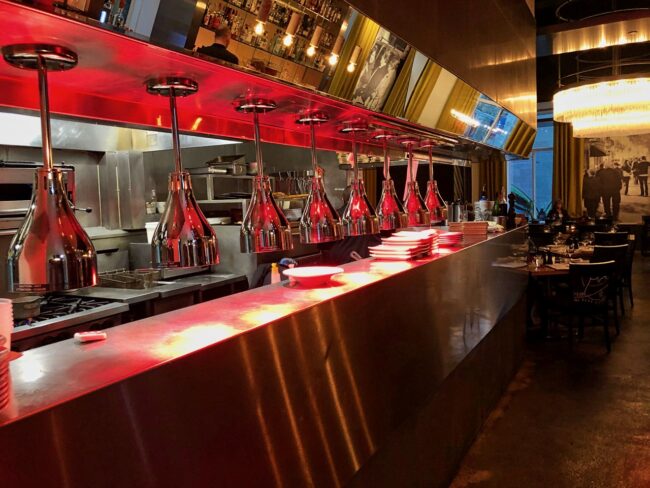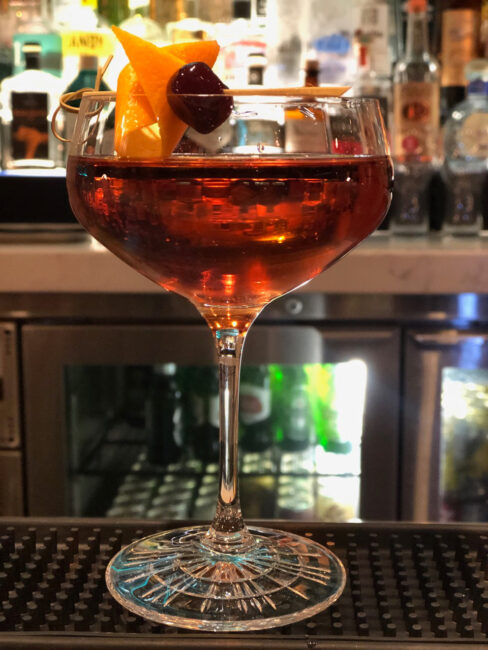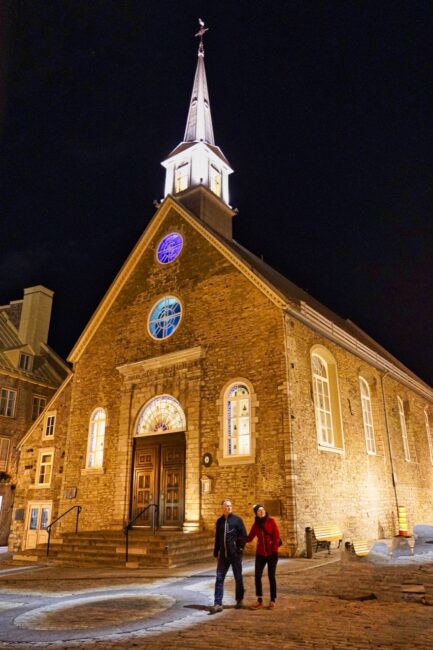
CHAPTER TEN: A QUÉBEC CITY CIVICS & HISTORY LESSON
March 19, 2020
CHAPTER TWELVE: A ROAD FIT FOR A KING
April 15, 2020Colorful Québec: Mai Tai Tom’s 2019 Journey to Montréal & Québec City
CHAPTER ELEVEN: DAY TRIPPIN’ – QUÉBEC’S AUTUMN COLORS SHINE BRIGHTLY
Day Nine – Bus Driver Extraordinaire, Cascading Chute, Colors Aplenty, Old Man Walking, Is That Wilford Brimley?, Cone Heads, Copper Clappers, Not JR Tolkien’s House, A Basilica To Remember, Fall At The Falls, Blaming The GPS and A Final Farewell To Québec City
Our last day in Québec City would not actually be spent in Québec City because we were going to cruise the nearby countryside by bus and visit Chute Montmorency, an island where we’d taste some incredible ice cream, a copper store and Sanctuaire de Sainte-Anne-de-Beaupré. A quick stop in Cafe La Maison Smith in Place-Royale to pick up some sandwiches and cookies for lunch and then we took the Funiculaire du Vieux-Quebec up to Fairmont Le Château Frontenac for the final time.
Arriving a little early we strolled the promenade for a bit.
On the nearby Dufferin Terrace stands the Champlain Monument that honors the founder of the city back in 1608.
Alongside that monument is the UNESCO Monument, which commemorates Vieux-Québec’s designation as a World Heritage site in 1985.
The other nearby statue is the Récollets Monument. The Récollets were a “reform branch of Friars that became known as Franciscans, who served an important role as early missionaries to the French colonies in Canada, and earned immortality for reportedly brewing the first beer in New France in 1620.”
Before hopping on the bus, we saw the Canadian flag flying proudly over the Museé du Fort building.
At 10:30 we hopped on our bus for a tour that would take approximately two hours longer than Gilligan’s tour was supposed to take. Our bus driver, Jean, turned out to be one funny, and very informative guy who entertained our full bus during the entire five hours.
As we drove through the countryside to our first destination, Chute (Falls) Montmorency, Jean regaled us with historical stories and facts interspersed with some great humor. Dropping us off outside the Manoir Montmorency (which houses an interpretation center, gift shop and restaurant), he gave us specific instructions on what time we should meet back at the bus.
Autumn colors bedazzled as we hiked to the observation deck near the falls. Above us was the suspension bridge, where we would shortly walk over the falls.
Also on display was an alternate route to reach the falls. If a bus sounds too comfy, park at the bottom and take the 487-step Panoramic Staircase. My knees took one look at that staircase and thanked me for purchasing a bus ticket. There’s also a 300-meter double zip line once you get to the top.
We crossed the suspension bridge with the falls cascading beneath us as we traversed against a gusty wind.
Yes, it was a gorgeous day!
Indigenous people had long known about the waterfall, but it was the ever-present Québec founder, Samuel de Champlain, who named it Chute Montmorency. Charles de Montmorency was the Admiral of France and Brittany. Alas, he died without ever making it to Canada.
The cold blasts of air were invigorating, and the brilliant autumn colors were on full display. I told the group, “I guess you could call these Falls colors.”
I suddenly found myself alone.
We took a different walking route (but just as colorful) back to the bus and arrived shortly before the appointed time.
Along the way, these guys were as busy as beavers.
Unfortunately, one group got back to the bus late (as they would at a couple of other spots along the route). Personally, I would have left them there, which is why I will never be a tour director.
A short distance from the falls, we crossed a bridge and found ourselves on the charming Île d’Orléans, with a view back toward the city.
One of the passengers in front of me, turned and said, “You are in for a treat.” I knew he must be honest, because he looked just like Wilford Brimley. He added, “This will be the best ice cream you’ve ever tasted.”
Within minutes the bus pulled in front of Chocolaterie de l’île d’Orléans St-François.
Wilford said the chocolate-dipped cone was his favorite (turns out he’d taken the tour a few days previously, but returned to take some guests). And here I thought he was just a Quaker Oatmeal guy.
Tracy and I, however, decided to order the Blanc á l’érable (White with Maple).
Mai Tai Tom Helpful Hint: Be sure to get a spoon because as soon as the shell hardens, it is virtually impossible to bite into it. Oh, and it was really, really good!
Kim ordered the dark chocolate while Mary enjoyed her chocolate with salted caramel.
The island is best known for its agriculture, but as we continued on, we also admired the beautiful summer residences.
Passing by the falls once again, we headed toward our next destination. Mai Tai Tom Fun Fact: Chute Montmorency is 99 feet taller than Niagara Falls.
Along the way we paid our respects to the Addams Family and passed by a dwelling where hobbits must reside.
Next stop: Albert Gilles Boutique et Musée, a shop that has churned out embossed copper for 93 years. Upon entering, we were given the history of the family-owned shop and then a demonstration.
I walked around the museum and took some photos until I saw the dreaded “no photograph” sign.
Albert Gilles was renowned for his religious art, and his relief works are included on many churches in Canada, the United States and Jamaica. We’d also see his work at our next stop.
Hopping on the bus, we took a short, but very colorful, bus ride.
Ten minute ride from Albert Gilles Boutique et Musée stands Sanctuaire Sainte-Anne-de-Beaupré. The sky kept turning from blue to cloudy, but when we reached the basilica dedicated to the Virgin Mary’s mother (and Québec’s patron saint), the sky turned a cerulean blue hue. More than a million pilgrims visit this site each year.
Legend has it that St. Anne helped save sailors from shipwrecks on the St. Lawrence, so a wooden chapel was built here in 1658. It was demolished by a flood (hey, there’s only so much a saint can save), and a new church was built in the 1880s, which was subsequently destroyed by fire in 1922. Today’s Neo-Roman basilica was constructed in 1926 and finished in 1946.
The gold statue of St. Anne on top of the basilica is from the previous church that burned in 1922.
And what a basilica it is! It’s one of the most beautiful we have ever visited. Constructed in the shape of a Latin cross, the interior comprises 22 chapels, 18 altars and a staggering 214 stained glass windows. This stained glass windows of the transepts (right) are dedicated to Saint Anne recalling “two great sanctuaries, one in Brittany and the other in Jerusalem.”
Before stepping inside we saw the doors (700 pounds each) that have reliefs depicting scenes from the Gospel courtesy of the dedicated work of Albert Gilles. There’s also a statue of Mary, among many others adorning the basilica.
We were given 40 minutes to tour the basilica, and although that is usually more than enough time to visit most churches, it certainly was not to visit this masterpiece of architecture.
Mai Tai Tom Fun Fact: We were told there are more than three million glittering mosaic pieces in the basilica all of which had to be rebuilt after the fire in 1922.
The magnificent mosaic ceiling details the life of St. Anne (called “Good Saint Anne”), shown with Mary and baby Jesus below. In this scene at the heart of the apse, Anne is giving fruit to Jesus (even back then they knew the importance of 5 A Day).
The Statue of St. Anne is a spot where pilgrims gather.
Below is The Chapel of the Calvary.
I think this chapel had something to do with birth.
In this chapel is a Holy relic of Saint Anne presented to the basilica by Pope John XXIII.
There were also “Radiant Chapels,” each one dedicated to a saint. That’s Saint Alphonsus on the left and St. Patrick on the right welcoming pilgrims from Ireland.
St. Joseph was the son-in-law of Saint Anne, and I also believe the inventor of aspirin for children. Don’t hold me to that.
Other radiant Chapels include …. St. Benedict and St. Joachim, the first husband of St. Anne.
St. John Baptist de la Salle (“The Teacher”) …
… and St. John The Baptist, patron of French Canadians. It was finally nice to see him with his head attached.
Finally, there is the Holy Family Chapel, and a ceiling mosaic from one of the rooms.
On the lower level of the basilica is the colorful Chapel of the Immaculate Conception.
It was quiet and peaceful down here.
The chapel is decorated with paintings
Mosaics representing nature are prevalent throughout the Chapel of the Immaculate Conception.
We visited a couple more chapels …
… wished we had more time …
… and it was back outside to savor what was still a gorgeous day at Sanctuaire Sainte-Anne-de-Beaupré.
As the clouds came back in, one last stop. This time we walked at the bottom of Chute Montmorency for a few more photo ops. If you don’t want to climb the stairs, this would be my choice from this area.
Mary met a friendly owl, who told her it was a “wise” decision to book this day trip.
It was back on the bus, where our jovial bus driver wasn’t so jovial when the same people from earlier were once again ten minutes late. Jean quickly got back into the spirit of the day regaling us with more stories as he drove back to where we started our excursion. I would highly recommend this tour as a stress-free way to spend your day combining nature with architecture (and ice cream).
Kim and Mary went to collect our rental car, as we’d be driving to the Montréal airport tomorrow afternoon. Their trip back to the hotel was quite eventful as the GPS system led them down not one, but two, wrong way streets. That’s their story, and they’re sticking to it!
Back at Hotel Priori we packed our bags and at 7:30 headed across the street to dinner at Ristorante il Matto. The modern looking restaurant had a nice feel to it, but unfortunately we had a server who must have been on her first day. Service was uneven, and the food, truthfully, was nothing to write home (or in this post) about.
Afterward, while Tracy and Mary were having a last cocktail at Bar Artefact …
… Kim and I took one last stroll around old Québec City. Passing by Église Notre-Dame-des-Victoires on Place-Royale one last time …
… we headed down the steps where we would soon be at Quartier Petit Champlain …
… and the welcoming umbrellas.
The old town was quiet on this Friday night. The cruise ship passengers were back in their cramped cabins, while we had the town almost all to ourselves.
Even with it being so quiet, our little friend, peering hopefully inside, was still unable to grab a table at the restaurant.
One last frescoed building, and Québec City was history.
Québec City had been a wonderful experience, but our time in Canada was growing short.
Tomorrow, we’d hit Chemin du Roy for a drive as we headed to the Montréal airport for our flights home. We would, of course, hit a couple of historic churches along the route. As I settled into our comfortable Hotel Priori bed, I was halfway asleep when I awoke with a start and had a terrible thought .… “Damn, I still haven’t eaten any poutine!!!!”
NEXT: CHAPTER TWELVE – A ROAD FIT FOR A KING & EPILOGUE
Day 10 – Rolling By The River, Last of the French Regime, Final Resting Places, High Chairs, Church Shut Out and Desperately Trying To Find Poutine
















